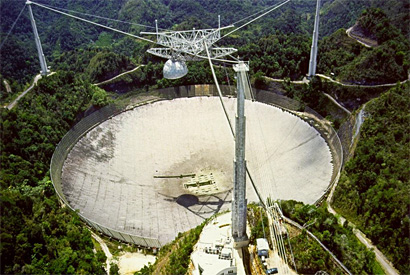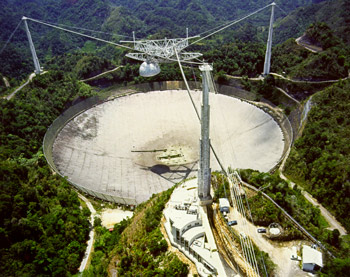UC Berkeley a pioneer in citizen science
Calbug is just the latest example of UC Berkeley putting a call out to the masses for help with large-scale science projects.

May 22, 2013

SETI@home participants help analyze data gathered by the Arecibo Observatory, site of the world’s largest, single-dish radio telescope. (Photo courtesy of the NAIC-Arecibo Observatory, a facility of the National Science Foundation)
Calbug is just the latest example of UC Berkeley inviting the public to help with a large-scale science project. Before Calbug, there was SETI@home, one of the earliest and most successful volunteer-oriented research projects in the world. Launched in 1999, SETI@home continues to enlist citizens to download software onto their computers to analyze chunks of radio data from space in the search for extraterrestrial intelligence.
Notably, some of the earlier citizen science projects looked to the stars, including Stardust@home, built by UC Berkeley physicists. Volunteers helped find tiny particles of interstellar dust from stars many light years away from Earth with the aid of a virtual microscope that runs off of a Web browser.
Back on Earth, the public can help track sudden oak death disease through SOD Blitz, a program headed by Matteo Garbelotto, adjunct professor and cooperative extension specialist in the Department of Environmental Science, Policy and Management. Volunteers are trained to identify SOD symptoms and to collect samples for laboratory examination.
Garbelotto also relied upon citizen scientists for a major project to barcode the entire fungal collection of Italy’s Venice Museum of Natural History. Volunteers, many of whom were amateur mycologists, went online to help curate the samples in the collection. The results of the project were reported in the April 30 issue of the journal PLOS ONE.

Mycena rosea, or the rosy bonnet, is a species of mushroom barcoded by citizen scientists in Italy. (G.Robich photo)
“This study shows that collaboration with volunteers does not have to be limited to collecting organisms, but can expand into basic science,” said Garbelotto.
A fungi citizen science project closer to home is being developed through the North American Mycoflora Project led by Tom Bruns, professor of plant and microbial biology. Citizen scientists are being recruited to help create the continent’s first ever comprehensive guide to macrofungi, which includes mushrooms and truffles.
The rise of Web-based tools and platforms makes citizen science projects possible.
“To really make these contributions to science meaningful, people need to be engaged at some level, and technology is making that possible,” said Bruns.
“The ability to coordinate groups from around the world instantaneously to share all kinds of information,” he added, “is revolutionizing science.”
RELATED INFORMATION
- Help wanted: Public needed to uncover clues in natural history collections (UC Berkeley press release)